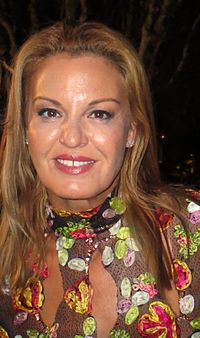Stefka Kostadinova
|
Stefka Kostadinova |
|||||||||||||||||||||||||||||||||||||||||||||||||||||||||||||
| nation |
|
||||||||||||||||||||||||||||||||||||||||||||||||||||||||||||
| birthday | March 25, 1965 | ||||||||||||||||||||||||||||||||||||||||||||||||||||||||||||
| place of birth | Plovdiv | ||||||||||||||||||||||||||||||||||||||||||||||||||||||||||||
| size | 180 cm | ||||||||||||||||||||||||||||||||||||||||||||||||||||||||||||
| Weight | 60 kg | ||||||||||||||||||||||||||||||||||||||||||||||||||||||||||||
| Career | |||||||||||||||||||||||||||||||||||||||||||||||||||||||||||||
|---|---|---|---|---|---|---|---|---|---|---|---|---|---|---|---|---|---|---|---|---|---|---|---|---|---|---|---|---|---|---|---|---|---|---|---|---|---|---|---|---|---|---|---|---|---|---|---|---|---|---|---|---|---|---|---|---|---|---|---|---|---|
| discipline | high jump | ||||||||||||||||||||||||||||||||||||||||||||||||||||||||||||
| Best performance | 2.09 m | ||||||||||||||||||||||||||||||||||||||||||||||||||||||||||||
| society | Trakia Plovdiv | ||||||||||||||||||||||||||||||||||||||||||||||||||||||||||||
| status | resigned | ||||||||||||||||||||||||||||||||||||||||||||||||||||||||||||
| Medal table | |||||||||||||||||||||||||||||||||||||||||||||||||||||||||||||
|
|||||||||||||||||||||||||||||||||||||||||||||||||||||||||||||
|
|||||||||||||||||||||||||||||||||||||||||||||||||||||||||||||
Stefka Kostadinova ( Bulgarian Стефка Костадинова , English transcription Stefka Kostadinova ; born March 25, 1965 in Plovdiv ) is a former Bulgarian high jumper . Kostadinova became an Olympic champion in 1996 . Since August 30, 1987, she holds the high jump world record with 2.09 m.
life and career
Stefka Kostadinova originally wanted to be a basketball player, but then switched to athletics, where there was less competition. She began with regular training with Dobri Iwanow and E. Todorow at the children's and youth sports school in her hometown of Plovdiv and counted the German high jumper and two-time Olympic champion Ulrike Meyfarth among her role models. At the age of 15, she jumped 1.84 meters.
Kostadinowa crossed the 2-meter mark for the first time in 1984. Then she developed into the dominant high jumper. In 1986 Kostadinova equalized the two-year-old world record of her compatriot Lyudmila Andonova with 2.07 m . Six days later, she corrected it by an inch. In the same year she won the title at the European Championships in Stuttgart . She crowned her athletic development at the 1987 World Championships in Rome . With the world record height of 2.09 m, she became the title holder. She won 34 high jump competitions in a row in the 1980s and after a defeat by Heike Redetzky (later Henkel ) another winning streak followed with 19 successes. From 1989/90 Kostadinova could no longer build on earlier successes after a serious knee injury, a broken foot and subsequent operations, whereupon she was replaced by Heike Henkel as the dominant high jumper. Originally she had planned to increase the world record in the high jump in the style of Serhiy Bubka to 2.15 m. During the period of socialism in Bulgaria, her keen business acumen earned her strong criticism , as she did not attend meetings if the entry fee seemed too low to her.
Kostadinova's Olympic career was initially more disappointing. In 1984 she was not allowed to participate because of the boycott of the Los Angeles Games by the Eastern Bloc countries . At the 1988 Games in Seoul and 1992 in Barcelona , she stayed under her form and finished only second and fifth. After that, Kostadinova interrupted her career for the birth of her child.
In 1995, however, she returned to the international athletics scene and built on her old successes. At the World Championships in Gothenburg she secured the title ahead of the German Alina Astafei and the Ukrainian Inha Babakowa . Kostadinova kept her form and won the Olympic gold medal for the first time at the 1996 Olympic Games in Atlanta with 2.05 m.
The following year she won her fifth title at the World Indoor Championships in Paris . In the summer of 1997, she injured her left foot. After two operations, she ended her active career in 1998. In total, she successfully jumped over 2.00 meters 197 times, more often than any other high jumper. She won the election for Sportsman of the Year four times in her home country, more often than any other Bulgarian athlete.
With a height of 1.80 m, Kostadinova's competition weight was 60 kg. She competed for her hometown club Trakia Plovdiv and was later trained by Nikolai Petrov, whom she married in 1989. Kostadinowa was characterized above all by her starting speed (100-meter best time: 11.68 s). She struggled to compete in rainy conditions after injuring herself on wet surfaces early in her career.
On November 11, 2005, Stefka Kostadinova was elected President of the Bulgarian Olympic Committee . Before that, while still active as a high jumper, she started organizing sporting events for orphans in her home country.
In October 2012, Kostadinova was inducted into the IAAF Hall of Fame .
World record development
- 2.07 m, May 25, 1986, Sofia
- Lyudmilla Andonova's world record set
- 2.08 m, May 31, 1986, Sofia
- 2.09 m, August 30, 1987, Rome
Awards
- Bulgaria's Sportswoman of the Year: 1985, 1987, 1995, 1996
- 2012: Induction into the IAAF Hall of Fame
Web links
- Stefka Kostadinova in the database of World Athletics (English)
- Stefka Kostadinowa in the Sports-Reference database (English; archived from the original )
Individual evidence
- ↑ a b c d Stefka Kostadinowa . In: Internationales Sportarchiv 13/1996 from March 18, 1996, supplemented by news from MA-Journal up to week 46/2005 (accessed via Munzinger Online ).
- ↑ a b Simeonova, Diana: ( AFP ): Athletics: Bulgaria's high jump queen ready to relinquish crown . October 19, 2007, 5:17 PM GMT (accessed via LexisNexis Economy ).
| personal data | |
|---|---|
| SURNAME | Kostadinova, Stefka |
| ALTERNATIVE NAMES | Костадинова, Стефка; Kostadinova, Stefka |
| BRIEF DESCRIPTION | Bulgarian high jumper |
| DATE OF BIRTH | March 25, 1965 |
| PLACE OF BIRTH | Plovdiv |

